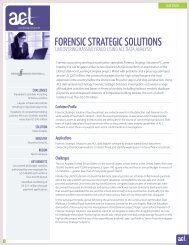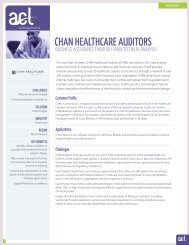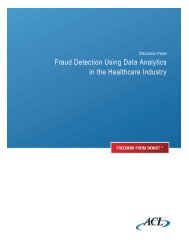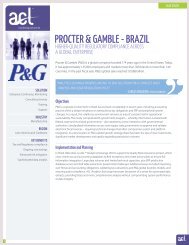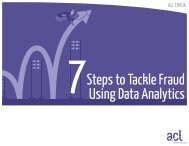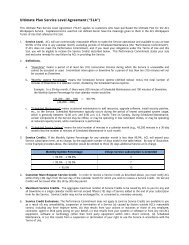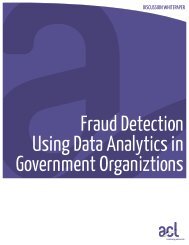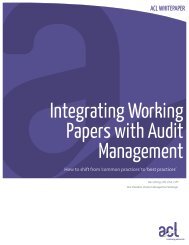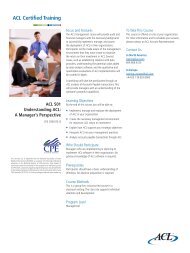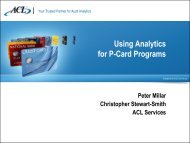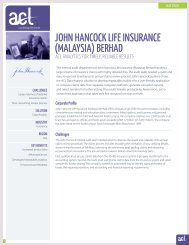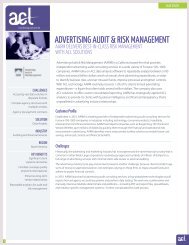ACL Audit Analytic Capability Model - Acl.com
ACL Audit Analytic Capability Model - Acl.com
ACL Audit Analytic Capability Model - Acl.com
You also want an ePaper? Increase the reach of your titles
YUMPU automatically turns print PDFs into web optimized ePapers that Google loves.
WHITE PAPER<br />
False positives are also <strong>com</strong>mon. If continuous monitoring produces mass numbers of false or<br />
insignificant positives on an ongoing basis, the process will usually grind to a halt.<br />
Organizational Risks<br />
As with any system implementation process, there are risks that the project will not achieve the desired<br />
out<strong>com</strong>es. For example, the continuous monitoring processes may not reveal any significant instances of<br />
control failures, even though from an audit perspective it may be that a lack of exceptions indicates there<br />
is assurance that controls are working effectively. As a result, business owners may fail to see the value of<br />
the process and dismiss or terminate the audit program – a risk that could have a long-term negative<br />
impact.<br />
How to Optimize<br />
The following are areas an organization should consider when looking to improve the effectiveness of<br />
audit analytics at the Continuous Monitoring level:<br />
People<br />
■■<br />
■■<br />
Process<br />
■■<br />
■■<br />
■■<br />
■■<br />
Assign overall responsibility for the ongoing success of the continuous monitoring processes to an<br />
appropriate individual. This is a new business process, not simply a project.<br />
Allocate resources to the review and follow-up of exceptions according to the nature and severity of<br />
the exceptions identified.<br />
Establish ownership and the respective roles of audit and business process management. In principle,<br />
internal audit should be independent of the continuous monitoring process and pass all<br />
responsibility over to business management. In practice, audit is often the area that understands and<br />
has the capabilities to implement continuous monitoring, so it is possible to have a hybrid approach<br />
in which, for example, audit runs the testing processes and provides management with access to the<br />
resulting exceptions and reports that are produced. Management must then respond to the<br />
exceptions and resolve them where appropriate, usually by fixing problem transactions and<br />
improving relevant processes and controls.<br />
Once the continuous monitoring processes and results are assessed, the auditor needs to decide the<br />
impact on audit procedures. If, for example, continuous monitoring of the Purchase-to-Pay process<br />
indicates control problems only within one specific region, audit programs can be limited to those<br />
appropriate for the single area.<br />
The issue of false positives can be a significant one, especially if too many false positive exceptions are<br />
produced. Ideally, sufficient reiterative testing is performed to eventually eliminate false positives.<br />
Tests are modified to take account of specific transactions that fail a standard test but are not of actual<br />
control concern.<br />
False negatives also need to be considered. Continuous monitoring tests should be validated to<br />
ensure that specific control failures and problem transactions are correctly identified.<br />
Technology<br />
■ ■<br />
The technology requirements for continuous monitoring are very similar to those for continuous<br />
auditing, although usually with the addition of capabilities to support the management and reporting<br />
of exceptions and the workflow around their state of resolution.<br />
■■<br />
Graphical overviews (dashboards) of the status of continuous monitoring and results over a given<br />
timeframe are usually a valuable way of quickly assessing overall risk patterns and highlighting trends<br />
that need specific response. They can also be used to quantify findings and remediation efforts, which<br />
can serve to rapidly establish the value of continuous monitoring processes.<br />
15<br />
© 2013 <strong>ACL</strong> Services Ltd.<br />
<strong>ACL</strong> and the <strong>ACL</strong> logo are trademarks or registered trademarks of <strong>ACL</strong> Services Ltd. All other trademarks are the property of their respective owners.



